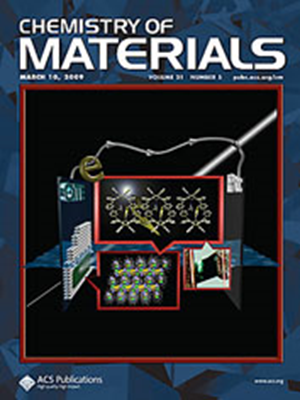Wearable Thermal Energy Storage Polymeric Materials via the Progressive Phase Change Strategy of Crystalline Bottlebrush Polysiloxane Networks
IF 7.2
2区 材料科学
Q2 CHEMISTRY, PHYSICAL
引用次数: 0
Abstract
Flexible polymeric solid–solid phase change materials (PCMs) have garnered continuous attention owing to their potential for thermal management in flexible/wearable devices and their non-leakage characteristics. However, it is still a big challenge to obtain polymeric solid–solid PCMs with both flexibility and high latent heat. In this study, bottlebrush phase change polysiloxane networks with alkyl side chains of different lengths (Si-X) are prepared through a one-step grafting cross-linking process. The influence of the length of the grafting chain on the mechanical and thermomechanical properties, phase change behavior, rheological characteristics, and thermal stability of materials is systematically studied. Furthermore, the concept of progressive phase change is proposed by cografting of crystalline side chains with multiple lengths in bottlebrush polysiloxane networks, which reduces the dense packing of crystals. The resulting network (Si-ODDT-70) exhibits excellent latent heat (ΔHm = 128.0 J/g; ΔHf = 129.1 J/g) and elongation at break values exceeding 200 and 450% at room and body temperatures, respectively. In addition, Si-ODDT-70 can be freely coiled, rolled, cut, and repaired with UV light at room temperature. Besides, the recyclable, stretchable/bendable, and multiresponsive phase change composites are obtained by combining the liquid metal/graphene paper with Si-ODDT-70. The first proposed cografting strategy offers a solution to unify the flexibility and high latent heat of PCMs, which will further enrich bottlebrush polymer network topology structures and guide the future design of flexible polymeric PCMs.

基于结晶瓶刷式聚硅氧烷网络渐进相变策略的可穿戴热储能聚合物材料
柔性聚合物固固相变材料(PCMs)由于其在柔性/可穿戴设备中的热管理潜力和无泄漏特性而受到了持续的关注。然而,如何获得既具有柔韧性又具有高潜热的聚合物固体-固体相变材料仍然是一个很大的挑战。本研究通过一步接枝交联工艺制备了具有不同长度烷基侧链(Si-X)的瓶刷状相变聚硅氧烷网络。系统地研究了接枝链长度对材料力学和热力学性能、相变行为、流变特性和热稳定性的影响。此外,通过在瓶刷式聚硅氧烷网络中接枝不同长度的晶体侧链,提出了渐进相变的概念,从而减少了晶体的密集堆积。所得网络(Si-ODDT-70)具有优异的潜热(ΔHm = 128.0 J/g;ΔHf = 129.1 J/g),室温和体温下断裂伸长率分别超过200%和450%。此外,Si-ODDT-70可以在室温下自由卷曲,轧制,切割和紫外光修复。此外,将液态金属/石墨烯纸与Si-ODDT-70结合,获得了可回收、可拉伸/可弯曲、多响应的相变复合材料。第一个提出的共接枝策略提供了一种统一pcm柔性和高潜热的解决方案,将进一步丰富瓶刷聚合物网络拓扑结构,指导未来柔性聚合物pcm的设计。
本文章由计算机程序翻译,如有差异,请以英文原文为准。
求助全文
约1分钟内获得全文
求助全文
来源期刊

Chemistry of Materials
工程技术-材料科学:综合
CiteScore
14.10
自引率
5.80%
发文量
929
审稿时长
1.5 months
期刊介绍:
The journal Chemistry of Materials focuses on publishing original research at the intersection of materials science and chemistry. The studies published in the journal involve chemistry as a prominent component and explore topics such as the design, synthesis, characterization, processing, understanding, and application of functional or potentially functional materials. The journal covers various areas of interest, including inorganic and organic solid-state chemistry, nanomaterials, biomaterials, thin films and polymers, and composite/hybrid materials. The journal particularly seeks papers that highlight the creation or development of innovative materials with novel optical, electrical, magnetic, catalytic, or mechanical properties. It is essential that manuscripts on these topics have a primary focus on the chemistry of materials and represent a significant advancement compared to prior research. Before external reviews are sought, submitted manuscripts undergo a review process by a minimum of two editors to ensure their appropriateness for the journal and the presence of sufficient evidence of a significant advance that will be of broad interest to the materials chemistry community.
 求助内容:
求助内容: 应助结果提醒方式:
应助结果提醒方式:


